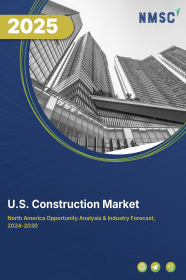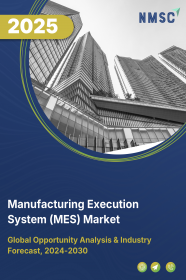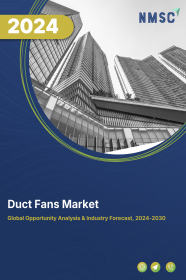
U.S. Construction Market by Type (Renovation, and New Construction), by Construction Method (Traditional, Prefabricated/Modular, 3D-Printed, and Green/Sustainable), by Contractor Type (Large Contractor, Medium Contractor, and Small Contractor), and Sector (Real Estate, Commercial, Infrastructure, Industrial) – Industry Trends and Forecast, 2025–2030
Industry: Construction & Manufacturing | Publish Date: 09-Jun-2025 | No of Pages: 85 | No. of Tables: 118 | No. of Figures: 63 | Format: PDF | Report Code : CM2194
U.S. Construction Industry Overview
The U.S. Construction Market size was valued at USD 1.77 trillion in 2024, and is projected to grow to USD 2.12 trillion by 2025. Additionally, the industry is expected to continue its growth trajectory, reaching USD 2.52 trillion by 2030, with a CAGR of 2.6% from 2025 to 2030.
The U.S. construction market is experiencing significant growth, driven by large-scale investments in infrastructure projects like the Hudson Tunnel Project, Brightline West High-Speed Rail, and the Gordie Howe International Bridge, which are enhancing transportation and connectivity.
Government-led initiatives, including funding from the Bipartisan Infrastructure Law, are also fueling this expansion, with numerous projects aimed at modernizing roads, bridges, airports, and energy infrastructure.
However, the market faces challenges due to complex regulatory processes and permitting requirements, which can delay projects and increase costs. At the same time, the integration of digital technologies like Building Information Modeling (BIM), AI, and IoT is creating new opportunities for enhanced project efficiency and collaboration, further supporting market growth.
Large-Scale Project Investments Drive Growth in the U.S. Construction Market Growth
The construction market in the United States is experiencing substantial growth, primarily fueled by a surge in large-scale project investments and infrastructure development.
Notable megaprojects in 2024 and 2025 include the Hudson Tunnel Project in New York City, a USD 16 billion initiative under the Gateway Program, with construction advancing in 2024 to build new rail tunnels under the Hudson River, enhancing Northeast Corridor connectivity; the Brightline West High-Speed Rail, a USD 10 billion project connecting Las Vegas to Southern California, with construction starting in 2024 for completion by 2028; and the Gordie Howe International Bridge in Detroit, a USD 6.4 billion cable-stayed bridge set to be North America’s longest, with completion slated for September 2025. These projects, supported by the U.S. Department of Transportation and private investments, significantly expand the construction market by boosting economic activity and infrastructure capacity.
Government-Led Infrastructure Initiatives Propel the U.S. Construction Market Trends
The construction market in the U.S. is undergoing significant expansion, driven by a growing number of government-led initiatives aimed at developing new infrastructure projects. In 2024, the Biden-Harris administration’s Bipartisan Infrastructure Law allocated USD 1.2 trillion, funding over 68,000 projects across transportation, broadband, and clean energy.
Key 2024–2025 initiatives include the USD 550 million I-10 Mobile River Bridge and Bayway multimodal project in Alabama, one of 180 infrastructure grants approved in 2025 totaling USD 3.2 billion, and the USD 9.5 billion JFK International Airport Terminal 6 project, advancing in 2024 to modernize New York’s aviation hub by 2026. These efforts, spanning roads, bridges, airports, and lead pipe replacements, aim to modernize infrastructure, enhance public safety, and promote sustainable development, significantly driving construction industry growth.
Navigating Regulatory Complexities Hinders the U.S. Construction Market Expansion
The construction market faces significant challenges due to stringent regulatory frameworks. Infrastructure projects encounter obstacles from the complex network of government regulations and permitting processes, which often require securing numerous permits and approvals from various governmental bodies at local, regional, and national levels. These approvals include zoning regulations, environmental assessments, compliance with building codes, safety standards, and other regulatory requirements.
Lengthy permit acquisition processes, bureaucratic inefficiencies, and inconsistencies in regulations across jurisdictions can substantially delay project timelines and increase costs.
Furthermore, fluctuations in regulations or unexpected policy changes can disrupt ongoing projects and deter potential investments. Regulatory bodies such as environmental agencies play a critical role in overseeing aspects like air quality, waste disposal, and water regulations, offering resources to ensure compliance during demolition, recycling, and the disposal of various materials and equipment.
Integration of Digitalization and BIM Presents Lucrative Opportunity for the Market Expansion
The construction industry is undergoing a significant digital transformation, driven by the increasing adoption of Building Information Modeling (BIM), which is opening up new avenues for growth. BIM supports digital design, simulation, and infrastructure oversight, improving precision, collaboration, and resource optimization.
Reflecting this trend, ALLPLAN launched Allplan 2024-1 in April 2024 to enhance BIM capabilities and streamline cloud-based workflows, underscoring the sector’s shift toward fully digital project execution. Moreover, the convergence of AI, IoT, and cloud technologies is further enabling real-time collaboration, predictive maintenance, and efficient facility management.
Competitive Landscape
The key players operating in the U.S. construction industry include Lennar Corp., D.R. Horton, Inc., PulteGroup, Inc., Jacobs Engineering, Fluor Corporation, AECOM, NVR, Inc., Toll Brothers, KBR, Primoris Services Corporation, McCarthy Building Companies, Inc., Balfour Beatty, Inc, Skanska USA Inc, Holder Construction Group, LLC, STO Building Group Inc., and others.
U.S. Construction Market Key Segments
By Type
-
Renovation
-
New Construction
By Construction Method
-
Traditional Construction
-
Prefabricated/Modular Construction
-
3D-Printed Construction
-
Green/Sustainable Construction
By Type of Contractor
-
Large Contractor
-
Medium Contractor
-
Small Contractor
By Sector
-
Real Estate
-
Residential
-
Affordable
-
Luxury
-
-
Commercial
-
Retail Buildings
-
Office Buildings
-
Hospitality
-
Healthcare Facilities
-
Educational Institutes
-
Entertainment Ventures
-
-
-
Infrastructure
-
Transportation
-
Airport
-
Port
-
Rail
-
Road
-
-
Water and Wastewater
-
Energy
-
Telecommunication
-
-
Industrial
-
Manufacturing Plant
-
Warehouses
-
Power Plants
-
Oil Refineries
-
Chemical Plants
-
Key Players
-
Lennar Corp.
-
D.R. Horton, Inc.
-
PulteGroup, Inc.
-
Doss & Horky Inc.
-
Fluor Corporation
-
AECOM
-
NVR, Inc.
-
Toll Brothers
-
KBR
-
Primoris Services Corporation
-
McCarthy Building Companies, Inc.
-
Balfour Beatty, Inc
-
Skanska USA Inc
-
Holder Construction Group, LLC
-
STO Building Group Inc
REPORT SCOPE AND SEGMENTATION:
|
Parameters |
Details |
|
Market Size in 2024 |
USD 1.77 Trillion |
|
Revenue Forecast in 2030 |
USD 2.52 Trillion |
|
Growth Rate |
CAGR of 3.6% from 2025 to 2030 |
|
Analysis Period |
2024–2030 |
|
Base Year Considered |
2024 |
|
Forecast Period |
2025–2030 |
|
Market Size Estimation |
Trillion (USD) |
|
Growth Factors |
|
|
Companies Profiled |
15 |
|
Market Share |
Available for 10 companies |
|
Customization Scope |
Free customization (equivalent up to 80 working hours of analysts) after purchase. Addition or alteration to country, regional, and segment scope. |
|
Pricing and Purchase Options |
Avail customized purchase options to meet your exact research needs. |

















 Speak to Our Analyst
Speak to Our Analyst

















